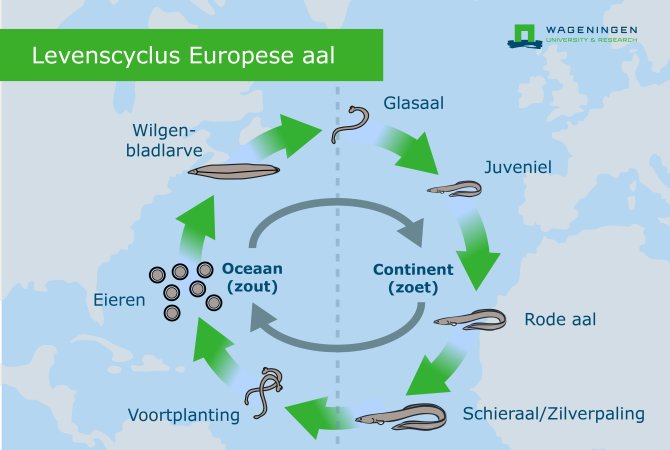
Glass eel monitoring
Newborn glass eels return to Europe from the Sargasso Sea. Data on the numbers of glass eels migrating into the Netherlands are of great importance for monitoring the eel population. Wageningen Marine Research has been monitoring this since 1938 at the sluices in Den Oever and now at many locations in the Netherlands.
Glass eel migration monitoring sites - See where we conduct our research:
The map below shows the locations where young glass eels are monitored. The monitoring at Den Oever is one of the longest time series for this fish species in Europe. In addition, there are 11 other collection points along the coast in the Netherlands where glass eels are sampled.
- Bathse Spuisluis - From 1991 onwards with several dozens of hauls per year
- Bergsche Diepsluis - From 1991 and, since 2007, with several dozens of hauls per year
- Den Oever Spuisluis - Since 1938 with several hundreds of hauls per year. The only site where fishing takes place every hour throughout the night (22:00-05:00). The data from this location is used for the ICES European glass eel trend at www.ices.dk.
- Harlingen – From 1992 onwards with several dozens of hauls per year
- IJmuiden – From 1969 onwards and since 1973 at a rate of several dozens of hauls per year. The data from this location is used for the ICES European glass eel trend at www.ices.dk.
- Katwijk – From 1991. There has been a change of location in 2010 (due to renovation). From 2016 onwards, fishing takes place at the 'sea side'. The data from this location is used for the ICES European glass eel trend at www.ices.dk.
- Krammerssluizen – From 1990 onwards with several dozens of hauls per year
- Lauwersoog – From 1976 onwards with several dozens of hauls per year. The data from this location is used for the ICES European glass eel trend at www.ices.dk.
- Nieuw Statenzijl – From 1996 onwards with several dozens of hauls per year
- Stellendam – 1971, 1972 and from 1988 onwards by several dozens of hauls per year. The data from this location is used for the ICES European glass eel trend at www.ices.dk.
- Termunterzijl - From 1991 onwards with several dozens of hauls per year.

How do we monitor?
Traditionally, glass eel sampling is carried out with a lift net in the months of March to May. On average, this is the most important migration period for glass eels in the Netherlands. Per location, dozens of hauls are carried out: three in an evening in the dark. Only at Den Oever are there several hauls every other hour in the evening, which results in several hundred hauls. Monitoring is carried out by volunteers and professional fishermen. The research is coordinated by Wageningen Marine Research.
The glass eel index
The index monitoring indicates the annual variation in glass eel abundance in front of a barrier such as a lock or a pumping station. It is essential that the methodology and the conditions remain the same in order to make a good comparison. Although monitoring is carried out from March to May, the index is determined for April and May. One year the glass eels are early and another year they are late. Practice shows that for one year this gives a higher value of the index, while the other year this gives a lower index. An index is nothing more than the number of glass eels per haul.
Different monitoring techniques
In addition to glass eel monitoring, research is also being conducted into the distribution dynamics and migration success of glass eels. By using multiple techniques during the same period at the same location, a more complete picture of glass eel behaviour is obtained.

